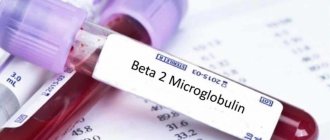Pyelonephritis
Colpitis
Thyrotoxicosis
Menopause
10318 15 October
IMPORTANT!
The information in this section cannot be used for self-diagnosis and self-treatment.
In case of pain or other exacerbation of the disease, diagnostic tests should be prescribed only by the attending physician. To make a diagnosis and properly prescribe treatment, you should contact your doctor. We remind you that independent interpretation of the results is unacceptable; the information below is for reference only.
Progesterone: indications for use, rules for preparing for the test, interpretation of results and normal indicators.
What is progesterone
Progesterone is a hormone of the female reproductive system, the synthesis of which occurs cyclically throughout the ovarian-menstrual cycle. The place of its synthesis is the woman’s ovaries, as well as the placenta during pregnancy.
The effects of this steroid substance in the female body are:
- Secretory transformations of the endometrium in the luteal phase. What does this mean? Due to estrogens, which are synthesized in the first phase of the cycle, active growth of the uterine mucosa occurs. Progesterone, on the contrary, has an antiproliferative effect. That is, it inhibits the growth of the endometrium, but ensures its secretory transformations (accumulation of glycogen in cells to ensure the trophic function of the embryo during pregnancy).
- Sedative effect.
- Relaxation of smooth muscle muscles (including the body of the uterus to maintain pregnancy). but progesterone, on the contrary, spasms the cervix, preventing the development of isthmic-cervical insufficiency during pregnancy.
- Transformations in the mammary glands to ensure lactation.
Causes of elevated progesterone levels:
- Presence of pregnancy;
- Hormonally active ovarian tumors;
- Chorionepithelioma;
- Bubble drift.
Reasons for decreased levels of the hormone progesterone in the blood:
- Luteal phase deficiency;
- Frozen (non-developing) pregnancy;
- Taking combined oral contraceptives.
When is it necessary to donate blood to check progesterone levels?
Since progesterone is a hormone, the level of which depends on the phase of the ovarian-menstrual cycle, therefore it is necessary to take it on certain days. If a woman is of reproductive age, and her cycle averages about 28 days, then the recommended interval for donating blood to check progesterone levels is days 21-23 of the ovarian-menstrual cycle.
The main functions of progesterone
- ensures the growth of glands in the uterine mucosa in the second half of the menstrual cycle;
- responsible for the regularity of menstruation;
- reduces the effects of estrogen;
- supports libido;
- its deficiency has a bad effect on a woman’s appearance;
- participates in the production of other steroids as an intermediate key link;
- thickens the mucus of the cervical canal, making it impermeable to sperm;
- promotes better embryo implantation by suppressing the immune system. Thanks to this, the embryo is not rejected by the mother’s body, and pregnancy occurs;
- inhibits lactation before the onset of labor, and a decrease in progesterone levels after the birth of a child is a signal for the production of prolactin;
- in the first trimester it suppresses spontaneous uterine contractions, relaxes the muscles of the uterus, protects the fertilized egg from rejection until the period of full formation of the feta-placental complex;
- probably, a decrease in progesterone concentration is the reason for the onset of labor;
- is a neurosteroid - affects the functioning of the brain;
- at the level of the central nervous system it helps to endure pregnancy and childbirth more easily.
Decoding indicators
If in the transcript of the analysis the progesterone indicator is indicated in ng/ml, then to obtain the most accurate indicator it is necessary to divide the figure by 3.18. The level of progesterone in the blood of boys and girls before puberty is the same and is less than 1.1 nmol/l. With the entry into adolescence, the beginning of hormonal changes and the active formation of sexual function, norms become different for children of both sexes. The production of progesterone outside of pregnancy largely depends on the stage of the menstrual cycle.
Indications for progesterone testing
Indications for prescribing a blood test for progesterone levels:
- presence of ovarian-menstrual cycle disorders in women;
- searching for the causes of infertility;
- the presence of dysfunctional uterine bleeding;
- identification of luteal phase insufficiency both in preparation for pregnancy and for the elimination or prevention of isthmic-cervical insufficiency during pregnancy (shortening of the cervix, which can lead to miscarriage/premature birth);
- miscarriage;
- infertility;
- embryogenesis disorder;
- lack of lactation;
- control over the course of pregnancy;
- spotting during pregnancy;
- metrorrhagia of unknown etiology;
- suspicion of disease of the genital and mammary glands, thyroid gland, adrenal glands;
- determination of ovulation;
- suspected ectopic pregnancy;
- complications during gestation;
- early treatment using progesterone in the regimen;
- control over the condition of the placenta and fetus;
- in the IVF program at the stimulation stage.
Research in women is also carried out if there is a suspicion of an appendage cyst, obesity, or metrorrhagia. In men - if the presence of abnormalities in the development of the testicles, adrenal dysfunction, or decreased potency is suspected.
Hormonal tests can be taken at the AltraVita clinic. If progesterone levels turn out to be underestimated or overestimated, then you can immediately consult a qualified gynecologist or endocrinologist and receive treatment prescriptions.
RULE #3
The days of the menstrual cycle for studying hormone levels are strictly regulated. Results obtained only on certain days may be informative.
OPTIMAL TIME FOR HORMONAL STUDY.
There is a certain rule that allows you to make the most informative and indicative hormonal analysis, which allows you to characterize the entire menstrual cycle (ovulatory, anovulatory, insufficient luteal phase of the cycle).
1. With a normal menstrual cycle
| FIRST PHASE OF THE CYCLE | |
| HORMONE | Optimal time for analysis |
prolactin (Prl);
thyroid hormones, i.e. thyroid hormones in blood plasma:
| Days 2-5 of the menstrual cycle Allowable maximum: day 7 of the cycle |
| SECOND PHASE OF THE CYCLE | |
| progesterone | 20-22 days of the menstrual cycle (with a 28-day cycle) |
2. For menstrual irregularities or infertility
| FIRST PHASE OF THE CYCLE | |
| HORMONE | Optimal time for analysis |
| luteotropic hormone (LH); follicle-stimulating hormone (FSH); prolactin (Prl); testosterone (T); estradiol(T); dehydro-epiandrosterone sulfate (DHA-S); thyroid hormones, i.e. thyroid hormones in blood plasma:
|
|
| SECOND PHASE OF THE CYCLE | |
| progesterone | There is no need to donate progesterone (with the exception of cases of infertility). |
How does progesterone increase during pregnancy?
If pregnancy occurs during the menstrual cycle, the corpus luteum continues to function until the placenta is formed, which also actively produces progesterone. The level of the hormone constantly rises and falls sharply just before childbirth.
I trimester 2.8 – 147.3 ng/ml
II trimester 22.5-95.3 ng/ml
III trimester 27.9-242.5 ng/ml
Increased progesterone levels during pregnancy
may indicate fetoplacental dysfunction, delayed placental maturation. In addition, high values may be observed when taking medications (for example, valproic acid or progesterone and its synthesized analogues).
Decreased progesterone levels during pregnancy
may indicate intrauterine growth retardation, placental insufficiency, insufficient function of progesterone-producing organs (corpus luteum or placenta), risk of miscarriage, and the possibility of true post-term pregnancy.
Complexes with this research
Women's anti-aging diagnostics Monitoring of basic blood parameters in a woman aged 40+ 12,070 R Composition
Advanced women's anti-aging diagnostics Advanced monitoring of basic blood parameters in a woman aged 40+ 28,680 R Composition
Entry into IVF Examination when a woman enters the IVF procedure RUB 23,020 Composition
IN OTHER COMPLEXES
- Female infertility RUB 16,210
- Miscarriage RUB 40,070
- Female hormones. Luteal phase 1,160 R
- IVF planning RUB 12,990
Norms by cycle phases
So, progesterone levels are different for different phases of the cycle. Let's look at the indicators:
- In the first phase, called follicular and lasting from the beginning of menstruation until ovulation, progesterone concentrations are minimal. Its level can range from 0.3 to 2.3 nmol/l.
- In the ovulatory second phase, during which the dominant follicle ruptures and a mature egg is released from it, the progesterone level increases slightly and reaches 0.45-9.4 nmol/l.
- During the luteal phase, when the corpus luteum begins to work, progesterone concentrations increase and reach peak values. During this period, norms will range from 7 to 57 nmol/l.
- When the next menstruation begins (in the absence of pregnancy), concentrations sharply decrease to the minimum levels characteristic of the 1st phase.
Fluctuations in progesterone levels during the menstrual cycle
Based on this, we observe obvious fluctuations in progesterone levels in a normal ovulatory menstrual cycle:
- Follicular phase - low level (0-0.3 ng/ml)
- Ovulatory phase - increase (0.75-3 ng/ml)
- Luteal phase – significant increase (1.2-15.9 ng/ml)*
In the second half of the cycle, after the egg is released from the follicle, a corpus luteum is formed in its place, producing progesterone. If pregnancy does not occur during the cycle, the corpus luteum stops functioning after some time.
Keeping a graph of basal temperature, used to track the moment of ovulation, is based on the hyperthermic effect of progesterone on the thermoregulation center: an increase in hormone production is accompanied by an increase in basal temperature (the difference between the average temperature in the follicular and luteal phases of the cycle is at least 0.4⁰).
In the absence of ovulation, progesterone levels remain approximately the same in all phases of the menstrual cycle.
*Please note that reference values may vary between laboratories!
Increased progesterone levels
observed with dysfunctional uterine bleeding (in a cycle with prolongation of the luteal phase), renal failure, a number of forms of secondary amenorrhea, as well as as a result of taking certain medications.
Decreased progesterone levels
may be an indicator of a chronic inflammatory process in the pelvic organs, dysfunctional uterine bleeding (in a cycle with a shortened luteal phase), amenorrhea (both primary and secondary), long-term existence (persistence) of the follicle in the ovary. In addition, low progesterone below threshold values is observed when taking a number of medications (ampicillin, estriol, cyproterone, etc.) and taking oral contraceptives.
OH-progesterone: normal
An analysis of the hormone concentration is taken on the 4th–5th day of the cycle. This must be done 8 hours or more after the last meal. If the adrenal glands are healthy and secrete OH-progesterone in sufficient quantities, the norm in women of childbearing age should be within the following range:
- 1.24–8.24 nmol/l - follicular phase;
- 0.91–4.24 nmol/l - ovulatory phase;
- 0.99–11.51 nmol/l - luteal phase.
During menopause, the hormone level decreases to 0.39–1.55 nmol/l. It can be increased in women during pregnancy:
- I trimester - 3.55–17.03 nmol/l;
- II trimester - 3.55–20 nmol/l;
- III trimester - 3.75–33.33 nmol/l.
Submission of analysis
If there is no pregnancy and the menstrual cycle is regular, then the woman donates blood on the 21st or 22nd day (counting from the first day of menstruation). The biomaterial is collected in the morning on an empty stomach under the condition of a fasting period that lasts at least six to eight hours.
Testing for progesterone.
Blood is taken from a vein: the woman sits on a chair or couch and places her hand on a horizontal, flat surface. The nurse applies a tourniquet above the elbow and asks you to actively use your fist. Next, the employee of the institution asks you to clench your fist, pierces the skin in the area of the vein with a needle, and when the hand relaxes, draws the required amount of biomaterial into the test tube. The blood is sent to a laboratory where progesterone levels are measured.










